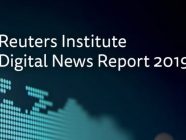Legacy media organisations must adapt to the internet age or they may lose their younger audiences. Accuracy and impartiality still matter, but traditional media must learn to adapt to the tone and ethos of the open web, by introducing greater transparency and becoming more interactive and open.
The media landscape has changed dramatically in the digital era, with business models shifting and new story-telling platforms emerging every day. The digital era has transformed the core of what journalists do and media organisations, both old and new, have been forced to adapt their editorial standards.
In a paper completed for the Reuters Institute for the Study of Journalism, I asked two key questions: Which journalistic standards still fit in this new age? And which standards form the basis of a new type of journalism being pioneered by hybrid news sites that have come of age in the digital era?
My paper, titled “Accuracy, Independence, and Impartiality: How legacy media and digital natives approach standards in the digital age”, focuses on three legacy organisations (the Guardian, the New York Times, and the BBC) and three digital outlets (Quartz, BuzzFeed, and Vice News). The Nieman Lab has a good summary of how these organisations are adapting their standards.
Overall, the outlook is promising. The arrival of a hyper-linked web has given audiences greater access to a range of facts, data, and opinions. Digital natives such as ProPublica, FiveThirtyEight, and Vox reveal their workings to build trust. Business site Quartz (owned by The Atlantic) has an innovative annotations system where the audience can offer their own facts or insights into a story, while sports and culture site Grantland demonstrates how a media outlet can deliver corrections that provide readers with greater context.
Editorial strengths the digital era offers include:
• Using hyperlinks to demonstrate accuracy and openness
• Greater context and timeliness for online corrections
• An inclusion of more voices which aids plurality
• Transparency in addition to (not in place of) impartiality.
But there are also some risks to journalistic standards, brought on by the internet:
• Speed and virality can threaten fairness and accuracy
• A lack of linear structure means all content is ‘flattened out’. Distinguishing between content types is difficult for outlets committed to impartiality
• Native advertising and an increase in PR-driven journalism may prevent audiences from making informed choices about what to believe and why.
Amongst my conclusions is an observation that a third form of journalism is emerging; one that combines the best of legacy standards and the new approaches of digital natives. This is a trend already spotted more broadly by Emily Bell of Tow (Columbia University) and Guardian columnist Frederic Filloux. Yet the same rings true of the way born-of-the-web organisations are reinventing standards for the 21st century.
Digital natives such as Quartz, Vox, and ProPublica are forging a new type of journalism which combines editorial integrity with a tone and presentation that is more “of the web”. It is increasingly important for legacy organisations to refine their standards to fit the digital era. Without adapting, they risk losing younger audiences to the wide array of other choices online.
To build trust and journalistic integrity in the digital age, media outlets must prioritise: greater transparency; more open forms of journalism (open source, open code, open data); and a voice that is of the web, driven largely by individual reporters rather than news brands.
Analysis should be facts-driven rather than opinionated and there must be a greater breadth of ideas and perspectives.
The internet age also demands content which is highly shareable via social platforms, but still accurate; interaction which places the reader as an expert, and better provision of context.
News organisations must now adapt their standards to meet this hybrid era in a way that strengthens a commitment to accurate, robust journalism but which also adopts the tone and ethos of the internet.
This article is available on EJO also in Albanian and Italian.
Photo credit: Free Press / Flickr Cc
Tags: digital news, impartiality, Journalism, standards, transparency













































